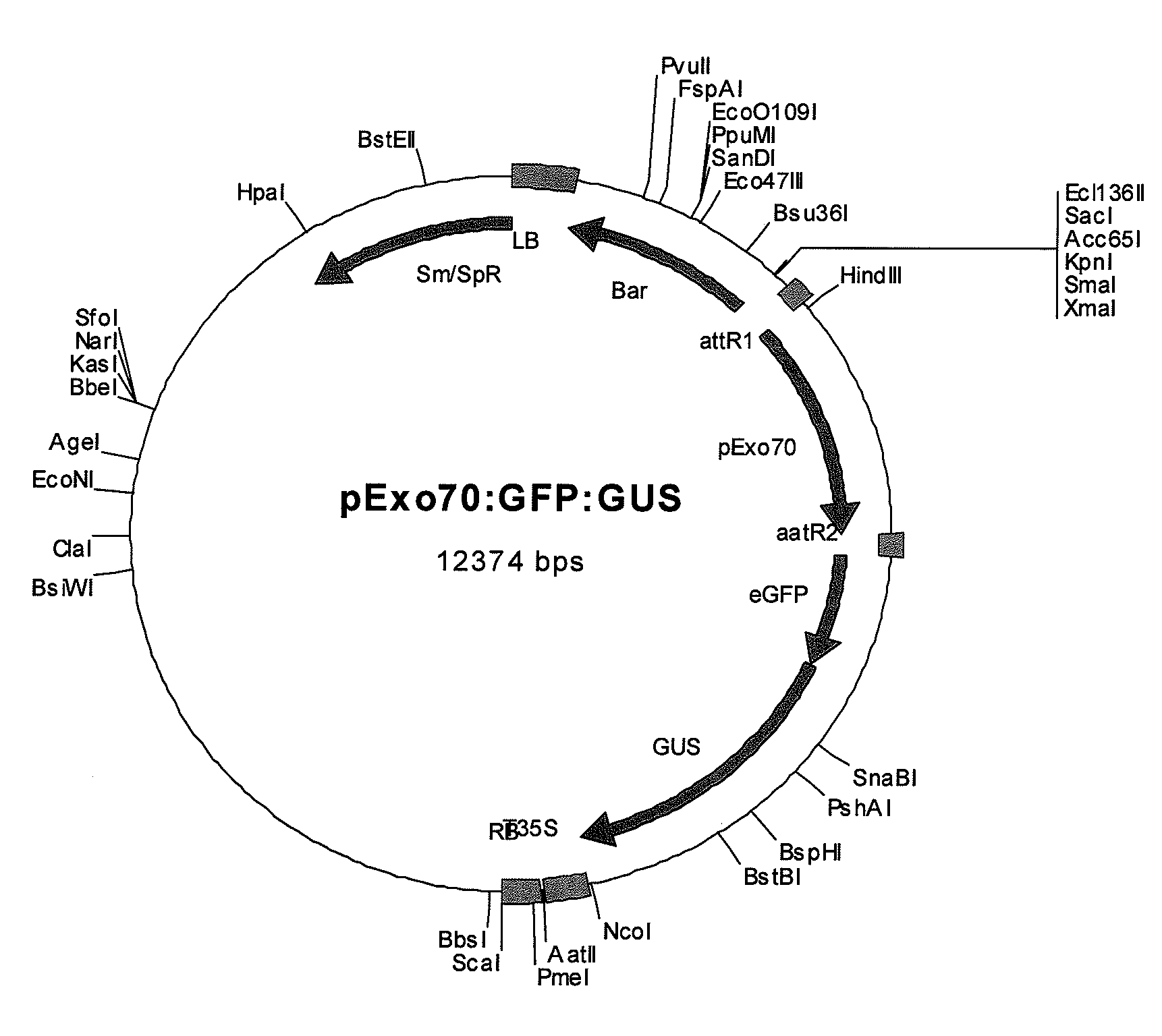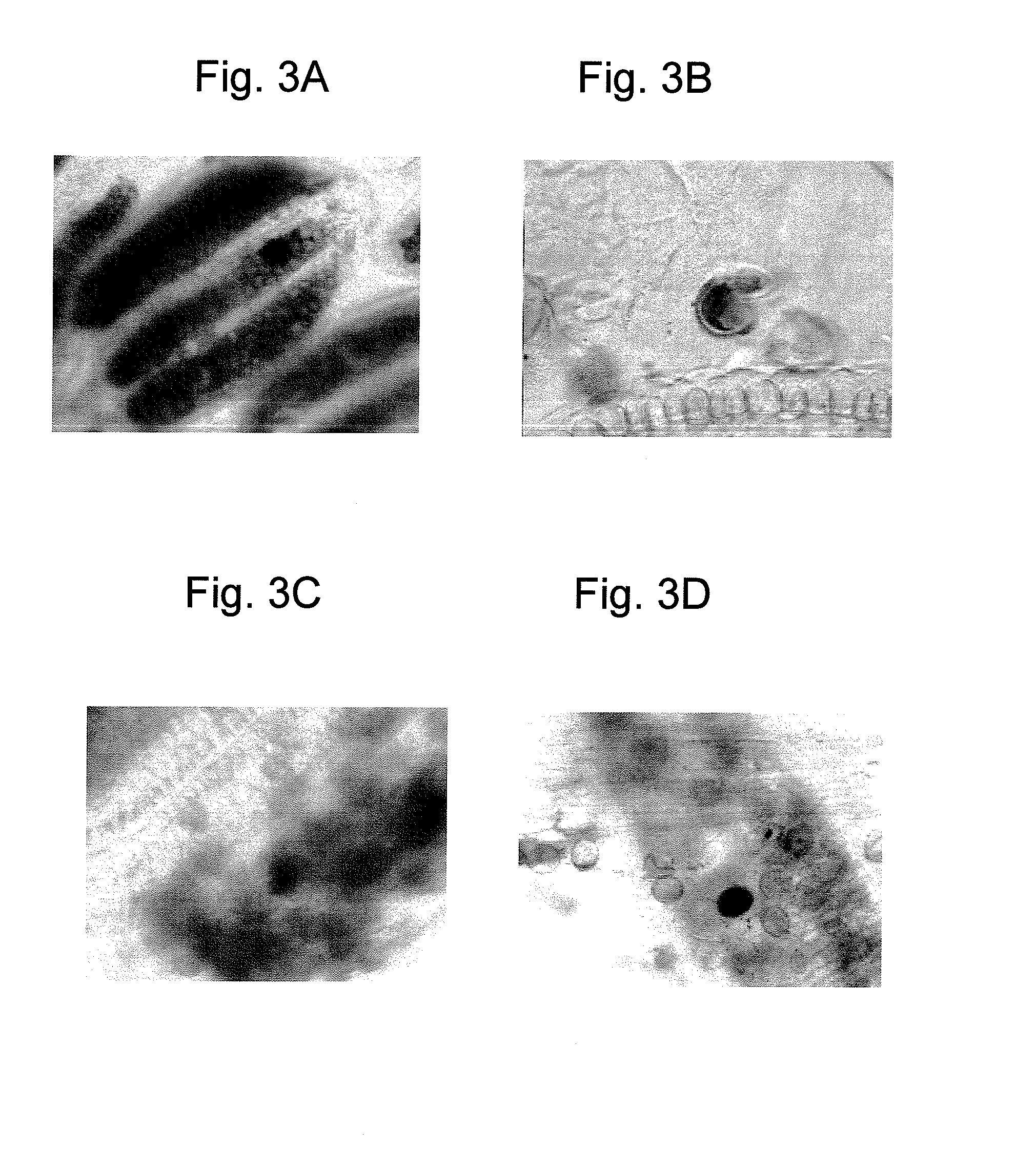Method Of Producing Haploid And Doubled Haploid Plant Embryos, And Embryos, Plants, Progeny, Cells, Tissues And Seeds Obtainable By Method
a technology of plant embryos and double haploids, which is applied in the field of new methods of producing haploid and double haploid plant embryos, can solve the problems of low success rate of many techniques, inability to utilize the enormous benefits of dhs to its full extent, and inability to achieve the effect of many techniques
- Summary
- Abstract
- Description
- Claims
- Application Information
AI Technical Summary
Benefits of technology
Problems solved by technology
Method used
Image
Examples
example 1
Transformation of Arabidopsis Pollen by Means of Particle Bombardment
[0062]The DNA plasmids pCAMBIA 1301 and pExo70::GFP:GUS were used to coat 1 μm gold particles. pCAMBIA 1301 is a binary vector, which contains GUS regulated by an 800 nucleotide CaMV 35S promoter (Roberts et al., pCAMBIA Vector release manual version 3.05 (1998)). pExo70::GFP:GUS contains -glucuronidase (GUS) and green fluorescent protein (GFP) (FIG. 6).
[0063]Three inflorescences of the Arabidopsis p35S:AP2mut were placed in the middle of a petri dish (FIG. 1). The petri dish was placed in the particle gun and three shots of the coated gold particles were fired. Two days after bombardment expression was studied. FIG. 2 shows a GUS positive pollen thus obtained.
[0064]The same experiment was repeated with the petri dish on level 3 in the particle gun. Two shots were fired at a pressure of 2200 psi. FIGS. 3A-D show representative results of this experiment.
[0065]It follows from this experiment that particle bombardmen...
example 2
In Vitro Pollen Germination After Particle Bombardment
[0066]Mature pollen is quiescent. After deposition of the pollen grain on the stigma of a female plant the process of pollen germination begins with rehydration through water transfer from the stigma. In the present example the pollen are germinated in vitro after particle bombardment.
[0067]FIG. 4 shows 15 different flower stages of tomato. Pollen of stage 1, 5 and 14 was used in this experiment. Pollen of stage 1 is completely mature and pollen of stage 5 is also mature. Stage 14 is the late-uni / early binucleate phase.
[0068]Pollen of flowers in stage 1, 5 and 14 was isolated in 200 μl NLN13 medium (NLN medium (Lichter R., Z Pflanzenzuecht 105:427-437 (1982)) supplemented with 13% sucrose). The 200 μl are spotted on a genescreen membrane and dried for 5 min. Then the membrane is placed on a ½MS agar plate and bombarded at 2200 psi with 1 μm gold particles coated with Exo70::GFP:GUS. After bombardment, the membranes are placed in ...
example 3
Preparation of Pollen Carrying a Cell Division Stimulating Factor for Inducing Cell Division of the Egg Cell After Pollination with These Pollen
[0069]Examples 1 and 2 demonstrate that pollen can be transformed in a model system with GUS. Here it is described how tomato pollen is transformed with the cell division inducing molecule BabyBoom (BBM)(Boutilier et al., 2002, supra) after irradiation of the pollen.
[0070]Pollen from a stably transformed plant carrying the CaMV 35S promoter::GFP construct were used. This construct is used as a visible non-destructive marker to discriminate between embryos and endosperm derived from a sexual event and embryos derived via the method of the invention. The CaMV 35S promoter is active in embryos and endosperm, but not in ovules and therefore only mark the sexually derived embryos. The plant that was used as pollen donor was homozygous for this CaMV 35S promoter::GFP construct.
[0071]The pollen were irradiated and the irradiation dose was selected ...
PUM
| Property | Measurement | Unit |
|---|---|---|
| pressure | aaaaa | aaaaa |
| green fluorescent protein | aaaaa | aaaaa |
| fluorescence | aaaaa | aaaaa |
Abstract
Description
Claims
Application Information
 Login to View More
Login to View More - R&D
- Intellectual Property
- Life Sciences
- Materials
- Tech Scout
- Unparalleled Data Quality
- Higher Quality Content
- 60% Fewer Hallucinations
Browse by: Latest US Patents, China's latest patents, Technical Efficacy Thesaurus, Application Domain, Technology Topic, Popular Technical Reports.
© 2025 PatSnap. All rights reserved.Legal|Privacy policy|Modern Slavery Act Transparency Statement|Sitemap|About US| Contact US: help@patsnap.com



